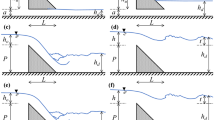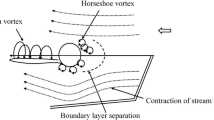Abstract
Laboratory experiments were conducted out to investigate the regimes of submerged flows over the sharp-crested weirs in sand bed Channel. These kinds of flows were classified as five states such as (I) impinging jet, (II) bed surface flow, (III) surface jump, (IV) surface wave, and (V) surface jet based on the depicted vector plots of the regimes. By increasing the submergence ratio, the impinging jet was developed as a downward jet which was impinged from the weir crest to the downstream. By continue the increasing, flow regime was developed as a bed-surface flow which is supposed that the impinging jet is turned as flow near the bed position instead of having a direct impact with the bed. Additionally, increasing constancy of the submergence ratio causes that the bed-surface regime turned to the surface jump which is accompanied by a hydraulic jump at the water surface. Subcritical condition at downstream of the weir which is provided by raising the tailwater due to constant flow discharge causes that the surface wave regime has vanished at the water surface of the downstream of the weir and some oscillating waves were transferred to downstream. Finally, by considering the maximum range of submergence ratio, the flow regime was changed to the surface jet which was accompanied by a big clockwise vortex at the lower water elevation. The present study classifies these flow regimes based on the velocity components (u, v, w). This approach was chosen by the authors to show the different classification between visual inspection and investigating the velocity direction by ADV. Then, an empirical equation was proposed to show the boundaries of the presented regimes. Also, a dynamic restriction was proposed based on experimental and literate data as a non-eroded status that is due to a submerge ratio, the scour hole is not provided at downstream of sharp-crested weir.









Similar content being viewed by others
Data availability
Some or all data, models, or code generated or used during the study are available from the corresponding author by request (data such as head-discharge and ADV measurements).
References
Ackers P, White W R, Perkins J A and Harrison A J 1978 Weirs and flumes for flow measurements. Wiley, Chichester, UK 327
Wu S and Rajaratnam N 1996 Submerged flow regimes of rectangular sharp-crested weirs. ASCE. J. Hydr. Eng. 122(7): 412–414
Wu S and Rajaratnam N 1998 Impinging jet and surface flow regimes at drop. IAHR. J. Hydr. Res. 36(1): 69–74
Azimi A H, Rajaratnam N and Zhu D Z 2014 Submerged flows over rectangular weirs of finite crest length. ASCE. JID Eng. 140(2): 148–160
Azimi A H, Qian Y, Zhu D Z and Rajaratnam N 2015 An experimental study on circular slurry wall jets. Int. J. Multiphase Flow. 74: 34–44
Azimi A H, Rajaratnam N and Zhu D Z 2016 Water surface characteristics of submerged rectangular sharp-crested weirs. ASCE. J. Hydraul. Eng. 142(5): 06016001–06016009
Guan D, Melville B W and Friedrich H 2015 Live-bed scour at submerged weirs. J. Hydraul. Eng. 141(2): 04014071–04014112
Skogerboe G V, Hyatt M L, Austin L H 1967 Design and calibration of submerged open channel flow measurement structures: Part 4-weirs. Utah Water Research Laboratory, Logan, Utah
Rajaratnam N and Muralidhar D 1969 Flow below deeply submerged rectangular weirs. J. Hydraul. Res. 7(3): 355–374
Ben Meftah M and Mossa M 2006 Scour holes downstream of bed sills in low-gradient channels. J. Hydraul. Res. 44(4): 497–509
Bormann N E and Julien P Y 1991 Scour downstream of grade-control structures. J. Hydraul. Eng. 117(5): 579–594
D’Agostino V and Ferro V 2004 Scour on alluvial bed downstream of grade-control structures. J. Hydraul. Eng. 130(1): 24–37
Gaudio R, Marion A and Bovolin V 2000 Morphological effects of bed sills in degrading rivers. J. Hydraul. Res. 38(2): 89–96
Melville B W and Friedrich H 2014 Flow patterns and turbulence structures in a scour hole downstream of a submerged weir. ASCE J. Hydraul. Eng. 140(1): 68–76
Lenzi M A, Marion A and Comiti F 2003 Interference processes on scouring at bed sills. Earth Surf. Process. Landforms. 28(1): 99–110
Lenzi M A, Marion A and Comiti F 2003 Local scouring at grade-control structures in alluvial mountain rivers. Water Resour. Res. 39(7): 1176
Lenzi M A, Marion A, Comiti F and Gaudio R 2002 Local scouring in low and high gradient streams at bed sills. J Hydraul. Res. 40(6): 731–739
Lu J Y, Hong J H, Chang K P and Lu T F 2012 Evolution of scouring process downstream of grade-control structures under steady and unsteady flows. Hydrol. Process. 27(19): 2699–2709
Marion A, Lenzi M A and Comiti F 2004 Effect of sill spacing and sediment size grading on scouring at grade control structures. Earth Surf. Process. Lancldforms. 29(8): 983–993
Marion A, Tregnaghi M and Tait S 2006 Sediment supply and local scouring at bed sills in high gradient streams. Water Resour. Res. 42(6): W06416
Melville B W 1997 Pier and abutment scour: integrated approach. ASCE. J. Hydraul. Eng. 123(2): 125–136
Pagliara S and Kurdistani S M 2013 Scour downstream of cross-vane structures. J. Hydro-environ. Res. 7(4): 236–242
Scurlock S M, Thornton C I and Abt S R 2012 Equilibrium scour downstream of three-dimensional grade-control structures. J. Hydraul. Eng. 138(2): 167–176
Guan D, Melville B W and Friedrich H 2014 Flow patterns and turbulence structures in a scour hole downstream of a submerged weir. ASCE: J. Hydraul. Eng. 140(1): 68–76
Salehi S, Esmailli K and Azimi A H 2019 Mean velocity and turbulent characteristics of flow over half-cycle cosine sharp-crested weirs. Flow Meas. Instrum. 66: 99–110
Wahl T L 2000 Analyzing ADV data using WinADV. ASCE Proc. Joint Conf. on Water Resources Engineering and Water Resources Planning and Management. Reston, VA. 10 p
Salehi S and Azimi A H 2019 Discharge characteristics of weir-orifice and weir-gate structures. J. Irrig. Drainage Eng. 145(11): 04019025
Salehi S, Azimi A H and Bonakdari H 2021 Hydraulics of sharp-crested weir culverts with downstream ramps in free-flow partially, and fully submerged-flow conditions. Irrig. Sci. 39(2): 191–207
Salehi S, Mostaani A and Azimi A H 2021 Experimental and numerical investigations of flow over and under weir-culverts with a downstream ramp. J. Irrig. Drain. Eng. 147(7): 04021029
Salehi S and Azimi A H 2022 Effects of spoiler and piggyback on local scour under single and twin submerged pipes. Ocean Eng. 261: 112137
Azimi A H and Salehi S 2022 Hydraulics of flow over full-cycle cosine and rectangular sharp-crested weirs. Can. J. Civ. Eng. 49(6): 954–968
Author information
Authors and Affiliations
Corresponding author
List of symbols
List of symbols
- d d :
-
Downstream scour depth (m)
- d dm :
-
Maximum downstream scour depth (m)
- d u :
-
Initial upstream scour depth (m)
- d 50 :
-
Mean diameter of sediment (mm)
- g :
-
Gravitational acceleration (m/s2)
- h :
-
Upstream weir head (m)
- h d :
-
Difference between upstream and downstream water level (m)
- H :
-
Upstream water level (m)
- L :
-
Scour hole length (m)
- Q :
-
Discharge (m3/s)
- t :
-
Tail water (m)
- u ave :
-
Averaged velocity (m/s)
- u *c :
-
Critical shear velocity (m/s)
- u c :
-
Critical threshold velocity (m/s)
- x :
-
Longitudinal direction
- y :
-
Transverse direction
- z :
-
Vertical direction
- Z :
-
Weir height (m)
- ρ :
-
Density of water (kg/m3)
Rights and permissions
About this article
Cite this article
Salehi, S., Moghadam, A.M. & Esmaili, K. Flow regimes of submerged rectangular sharp-crested weirs in sand bed channel. Sādhanā 48, 6 (2023). https://doi.org/10.1007/s12046-022-02053-4
Received:
Revised:
Accepted:
Published:
DOI: https://doi.org/10.1007/s12046-022-02053-4




